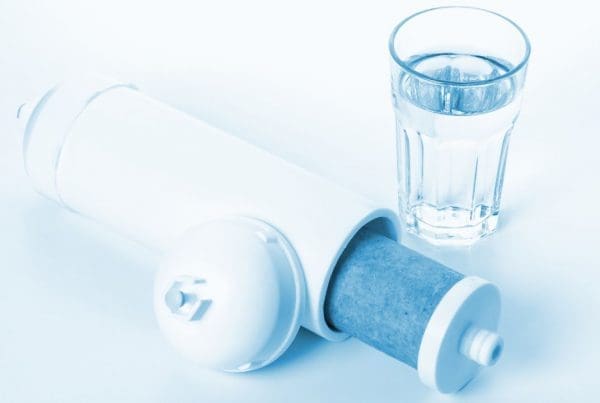 Unless you’re drawing water directly from an artesian well or other non-municipal water sources, it is extremely likely that you have fluoridated water. 92.4% of Indiana residents have access to fluoridated water. You may be wondering what fluoride is, and why it’s added to our water in the first place.
Unless you’re drawing water directly from an artesian well or other non-municipal water sources, it is extremely likely that you have fluoridated water. 92.4% of Indiana residents have access to fluoridated water. You may be wondering what fluoride is, and why it’s added to our water in the first place.
Fluoride is an inorganic compound that contains the element fluorine. It is commonly found in nature, including rocks, soil, and various minerals. It can also be found in water in low concentration. As well as added to many dental products and drinking water supplies to promote dental health. Today, we will talk about how fluoride in water may affect you and your family, and what your options are.
Fluoride: What Is It and Why Is It In Our Water?
Fluoride is a naturally occurring compound that can be found in very low concentrations in most groundwater, but ever since 1945, many American municipalities have been adding extra to their water. This is because fluoride promotes better dental health. Specifically, it helps prevent tooth decay. As tooth decay is the single most prevalent disease in the United States, affecting 94% of Americans over the age of 18, this effort to mitigate it has been met with widespread support, especially from public health authorities.
Fluoridation is understood to be a cheap, easy, and convenient way to improve dental outcomes, and is an early intervention that requires no opt-in or patient visitation. Since the start of fluoridation, long-term reviews have found that adding fluoride to water leads to decreased dental cavities in children and higher percentages of children without any cavities.
Why Remove Fluoride?
While it has been shown to be a safe and effective way to protect your dental health, many homeowners wish to remove it from their water.
One major reason is that homeowners cite too much fluoride in the water. The Department of Health and Human Services recommends a very low dose of only 0.7 mg of fluoride per liter of water consumed. This is to prevent dental fluorosis, a condition that changes the appearance of children’s dental enamel. However, sometimes this concentration can rise. A dose of 1.2 mg of fluoride per liter– nearly twice the recommended dose– is still within the HHS guidelines for fluoridation.
Another reason that people cite for wanting to remove fluoride is its over-exposure. The reasoning here is that we already have sufficient exposure from our toothpaste and that the extra amount in the water doesn’t actively contribute to dental health. People with this concern often feel that the fluoride levels in toothpaste are easier to control and that the exposure is limited to toothbrushing rather than every time you take a drink of water.
Fluoride is not completely harmless. At a low dose, it is helpful– but at higher concentrations, it can lead to some unpleasant medical conditions. At a high dose, exposure to fluoride can lead to skeletal fluorosis. Skeletal fluorosis is a metabolic bone disease usually seen in developing countries with contaminated groundwater. The exact dose for this risk varies; it may be as little as 2.4 mg per liter, or as high as 4.0 mg per liter per EPA standards.
People who get their water from deep wells or contaminated sources may have unhealthy levels of fluoride naturally occurring in their water.
It should also be noted that some people claim that fluoride causes cancer and wish to remove it from their water. While there is no conclusive evidence linking fluoride and cancer, this concern is representative of other health concerns that people have regarding fluoride in the water.
Ultimately, many homeowners feel like they haven’t been given a choice about whether or not they want the additional fluoride in their water. Since it is added at public water sources, you usually cannot opt out of fluoride in your water.
How Much Fluoride Is In My Water?
Most states report data to the CDC about how much fluoride is in their water. A few states (HI, MT, NJ, NM, NY, OH, SD, WA, WY, and Washington, DC) do not participate in this report program, called My Water’s Fluoride (MWF). Indiana is an MWF state, so our state’s water data can be seen on the CDC MWF program website.
If you can’t find your specific water provider, you can contact your local water provider; they are required to have test data for fluoride levels. If you have a private well and want to know how much naturally occurring fluoride is in your well water, you can contact the EPA or your local county board of health or municipal health department. These local departments may test your well water for free, so it is a good idea to ask them first.
Does Fluoride Cause Hard Water?
Hard water is caused by minerals, but fluoride is not one of the mineral culprits. The primary minerals responsible for hard water are calcium and magnesium. A water softener will not impact the amount that is in your water.
No matter your reason for removing fluoride from your water, you have limited solutions to consider. The obvious answer is filtration– but not all types of filtration can deal with fluoride effectively.
Filtration for Fluoride Removal
Most forms of water filtration will not remove fluoride from the water supply. Carbon filters, like the ones you may have in your refrigerator or attached to your tap, will not filter it either. This is also true of pitcher filters.
The best type of filter that will effectively remove fluoride from your water is a reverse osmosis (RO) filter. This type of filtration requires the installation of an RO system.
How Does Reverse Osmosis Work?
RO uses a semipermeable membrane to remove impurities from water. It works by applying pressure to the water on one side of the membrane, forcing it through while leaving the impurities behind.
There are several steps that your RO filter uses to clean and purify your water:
Pre-Filtration
In this first stage, the water enters the reverse osmosis system and goes through pre-filters to remove larger particles, sediment, and chlorine, which could potentially damage the RO membrane.
Pressure Application
The next step pressurizes the water and forces it through the semipermeable membrane. The membrane has extremely tiny pores that allow water molecules to pass through but block larger molecules, ions, and impurities. (We’ll come back to this step later when we discuss exactly how RO removes fluoride specifically from the water.)
Separation of Impurities
As the pressurized water passes through the RO membrane, impurities such as fluoride, dissolved salts, heavy metals, pesticides, and bacteria are left behind and flushed away as wastewater. This water may be recollected and cleaned in commercial or local systems.
Water Collection
This is the final state of the RO process. The purified water, also known as permeate, continues to flow through the membrane and is collected in a storage tank, ready for use.
RO filters typically have pre-membrane and post-membrane filters to scrub your water of anything the RO membrane misses. A system like this extends the life of your RO membrane by doing a first pass for larger sediments. This in turn means that your membrane will be more efficient and effective at filtering out tiny molecules like fluoride.
Reverse Osmosis for Fluoride in Water: Why It Works
RO can remove fluoride from water due to the properties of the semipermeable membrane and the electrical charge of fluoride ions. First, while these ions are small, the RO system’s semipermeable membrane’s pores are smaller. The membrane can effectively block their passage through the tiny pores, preventing them from entering the purified water. This separates the bulk that is present in the water; up to 80%-90% of the fluoride is eliminated.
Why Don’t Other Filters Remove Fluoride?
Activated carbon filters, such as pitcher filters or tap-mounted filters, are commonly used for general water filtration purposes. However, they are not specifically designed to remove fluoride.
Unlike RO filters, activated carbon filters primarily work by adsorption. Adsorption is the adhesion of particles in the water to the surface of the carbon filter. This traps the contaminants in the porous structure of the carbon filter material. This works for large contaminants, but fluoride ions are too small to be trapped.
Similarly, other types of filters like sediment filters, ceramic filters, or basic carbon block filters are not designed to target this. They primarily focus on removing larger particles, sediment, or improving taste and odor by reducing chlorine or some organic compounds.
Fluoride ions are ultimately just too small for most filters, making them difficult to capture using these conventional filtration methods.
What Else Can Reverse Osmosis Remove?
Reverse osmosis removes anything bigger than a water molecule. It’s not just limited to fluoride. This type of filtration includes, but is not limited to:
- Chlorine
- Lead
- Arsenic
- Mercury
- Cadmium
- Chromium
- Nitrates
- Pesticides
- Herbicides
- Sediments (such as sand, silt, and rust)
- Heavy metals (such as copper, zinc, and nickel)
- VOCs (Volatile Organic Compounds)
Installing a Reverse Osmosis System
If you’re concerned about fluoride in your water and want to remove it, your next step is choosing an RO system. Because these systems are complicated, it is best to find a professional installation company to assist you in choosing and installing a filter for reverse osmosis for water quality.
If you are located in Central Indiana and want to de-fluoridate your water, contact C and J Water today. We are happy to give you a free quote and free water analysis to help you find the best water filtration system for your family’s needs.




